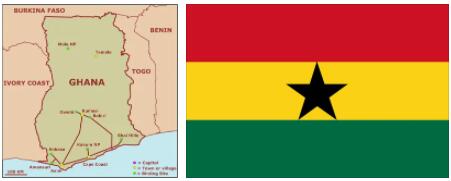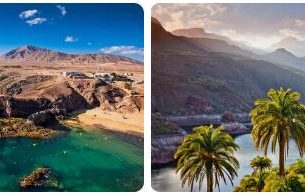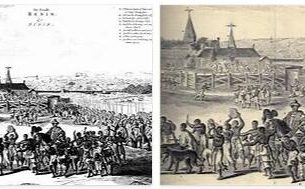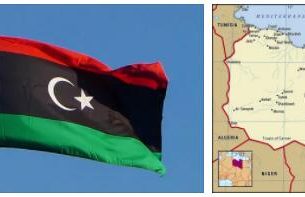Attractions
The west coast
The fish market in Dixcove and the 17th century British fort are nice places to visit. Nearby is Busua, a tropical beach with palm trees and high Atlantic waves. However, like almost the entire coast, swimming here is dangerous because the waves create a strong current. But there are small rocky coves where you can swim safely. Elmina (‘the mine’) was the first Portuguese settlement and has an interesting fully preserved 15th-century fortress.
Cape Coast and Takoradi: Everywhere in this region one comes across evidence of the colonial era. Cape Coast, the former capital of the “Gold Coast,” is overlooked by a castle where slaves were held captive before crossing to America. Today the castle houses the West African Historical Museum.
Accra and environs
Accra: The National Museum houses an extensive collection of Ghanaian art and an interesting memento of recent history: the statue of Kwame Nkrumah, the ‘father’ of independence, with his arms chopped off. Makola Market on Kojo Thompson Road is a sprawling street market where vendors from the surrounding villages sell their produce daily. Traditional handicrafts can be bought at the Center for National Culture.
- Searchforpublicschools: Offers schooling information of Ghana in each level – compulsory, technical and higher education programs.
Aburi is 38 km north of Accra in the Akuapim Hills. The sanatorium (now a Rest House ) built in the 19th century ) indicates the refreshing climate. The Botanical Garden was created during the colonial era and houses an extensive collection of subtropical plants and trees. Shai Hills Game Reserve : This relatively small game reserve is located 50 km from Accra and can be reached by car. Ada is a popular resort area at the mouth of the Volta. Anglers can catch barracuda and Nile perch in the estuary. Nearby is the salt marsh of Songow Lagoon, known for its rich bird life.
Ashanti Plateau
Kumasi is the historical capital of the Ashantis. Here you can see the ruins of Manhyia Palace and the Royal Mausoleum burned by Lord Baden-Powell. The cultural center is very interesting, with a museum mostly dedicated to the Ashantis, a library and an open-air theater. In the »Living Museum«, which consists of a farm and a replica village, you can see goldsmiths, potters and sculptors working according to traditional techniques. The weavers who produce colorful kente fabrics are particularly interesting.
The Owabi Conservation Area is to the west not far from Kumasi. Further northeast is the Boufom Wildlife Sanctuary with the impressiveBanfabiri Falls. To the south is the gold mining town of Obuasi.
Akosombo is the former settlement of the workers who built the Volta Dam, which created the world’s largest artificial lake. A holiday village with good water sports facilities is currently being built here. A round trip by car ferry to Kete Krachi takes one day; a three-day trip to the northern capital of New Tamale at the inlet of the lake is also possible. There are good opportunities for sailing, water skiing and other water sports.
The Mole National Park is the most beautiful wildlife sanctuary in Ghana. You can roam the park on foot or by Land Rover, but you must always be accompanied by a guide. Tours are timed to allow close viewing of antelope, monkeys, buffalo, warthogs and the rarer reintroduced lions and elephants. It is allowed to camp, visitors are not bound to prescribed paths. At the park entrance there is a motel with a restaurant. Not far from here, the Larabanga Mosque, Ghana’s oldest mosque, built in traditional West African style, can be visited.
Shopping
Overview
Smaller shops and market stalls offer a wide selection. Handicrafts from the Ashanti region and northern Ghana are just as nice souvenirs as handcrafted gold and silver jewellery. Modern and old works of art can also be bought, but the prices are high. Ashanti stools and brass weights, formerly used to weigh gold, are popular souvenirs. Stoneware pots, leather goods, woven shirts and bolgatanga baskets woven from multicolored raffia are sold in all the northern markets. Shop opening times: i. A. Mon, Tue, Thu, Fri 08.00-12.00 and 14.00-17.30, Wed, Sat 08.00-13.00.
Nightlife
Introduction
In Accra and other big cities you can find nightclubs with Western or African music.
Culinary
Overview
Many restaurants have a good selection of local specialties on the menu. Shrimp and other seafood are often offered on the coast. Local specialties include palm and peanut soups, kontomere and okro (stews) served with fufu (mashed cassava), kenkey or gari. Accra is also home to numerous Asian, Chinese, French and other European restaurants. Drinks: The local beer is similar to the European pilsner and is widely available.
Accommodation
Hotels
In the capital there are hotels of three international hotel chains. In Kumasi, Takoradi, Cape Coast, Sunyani, Koforidua, Bolgatanga, Tamale, Ho, Akosombo and other provincial capitals there are state and private hotels of international standard, guesthouses and basic accommodation. The classification is based on a star system. There are also government catering rest houses, simple accommodation with restaurants of varying quality. There are also motels in Mole National Park, on the west coast at Cape Coast and Elmina, and around larger towns. All of the above accommodation options are listed in the Hotel Guide of the Tourist Office (see Addresses). Information also on the Internet: www.ghanaweb.
Camping
Camping is allowed in the national parks but should be avoided. Visiting animal sanctuaries is only permitted when accompanied by an armed guide.
Culture
Religion
Christianity (63%), Islam (16%) and indigenous religions (21%).
Social Rules of Conduct
Manners: Ghanaians put i. General emphasis on formal salutation. They shake hands to greet each other. In much of West Africa it is customary not to touch food and other things with the left hand. Tipping: In Ghana it is customary to round up. Porters in the hotel are given 1-2 cedis.
Climate
Best travel time
Tropical climate. Hot and muggy in the Ashanti forest region and southwestern plains, hot and dry in the north.
The rainy seasons last from April to September in the north and from April to July and from September to November in the south.
The harmattan, a dry, hot desert wind, blows across the country from November to February. Rain showers are short-lived. There are no noticeable seasonal differences on the coast.
Although temperatures are most comfortable in Ghana during the rainy season from June to August, the country can be visited all year round. Wildlife viewing is best done during the dry season.
Country data
Phone prefix
+233
Area (sq km)
238533
Population
31,072,940 (Source: homosociety)
Population density (per square km)
110
Population statistics year
2020
Main emergency number
193



